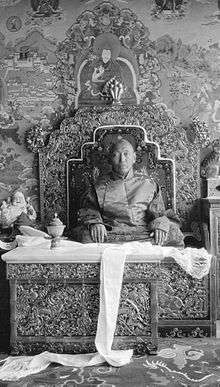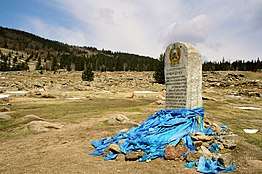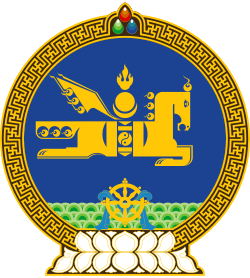Khata
A khata or khatag[1](Tibetan: ཁ་བཏགས་ ; Dzongkha: དར་, dhar, Mongolian : ᠬᠠᠳᠠᠭ / Mongolian: хадаг / IPA: [χɑtɑk], khadag or hatag, Nepali: खतक khada, Chinese 哈達/哈达; pinyin: hādá/hǎdá[2][3][4]) is a traditional ceremonial scarf in tengrism[5] and Tibetan Buddhism. It originated in Tibetan culture and is common in cultures and countries where Tibetan Buddhism is practiced or has strong influence.

| Khata | |||||||||
|---|---|---|---|---|---|---|---|---|---|
 A Tibetan khata. | |||||||||
| Tibetan name | |||||||||
| Tibetan | ཁ་བཏགས་ | ||||||||
| |||||||||
| Mongolian name | |||||||||
| Mongolian Cyrillic | хадаг | ||||||||
| Nepali name | |||||||||
| Nepali | खतक | ||||||||

The khata symbolizes purity and compassion and is worn or presented with incense at many ceremonial occasions, including births, weddings, funerals, graduations and the arrival or departure of guests. They were usually made of silk but now much more commonly cotton or polyester. Tibetan khatas are usually white, symbolising the pure heart of the giver,[6][7] though it is quite common to find yellow-gold khata as well. Tibetan, Nepali, and Bhutanese khatas feature the ashtamangala. There are also special multi-colored khatas. Mongolian khatas are usually blue, symbolizing the blue sky. In Mongolia, khatas are also often tied to ovoos, stupas, or special trees and rocks.
References
- Das, Sarat Chandra (1902). Rockhill., William Woodville (ed.). Journey to Lhasa and Central Tibet. London: Royal Geographical Society. p. 32. OCLC 557688339.
... handing him a scarf (khatag), I expressed the hope that we might meet next year.
- 现代汉语词典(第七版) [A Dictionary of Current Chinese (Seventh Edition).]. 北京. Beijing: 商务印书馆. The Commercial Press. 1 September 2016. p. 505. ISBN 978-7-100-12450-8.
【哈达】 hǎdá
- 现代汉语规范词典(第3版) [A Standard Dictionary of Current Chinese (Third Edition).]. 北京. Beijing: 外语教学与研究出版社. Foreign Language Teaching and Research Press. May 2014. p. 507. ISBN 978-7-513-54562-4.
【哈达】 hǎdá
- http://dict.revised.moe.edu.tw/cgi-bin/cbdic/gsweb.cgi?o=dcbdic&searchid=Z00000079118
- "The Eternal Blue Sky" (PDF). Hoop. 2014. Retrieved 2016-06-19.
- Staff. "Khata/Tibet "roof of the world"". Oracle ThinkQuest Education Foundation. Retrieved 2010-02-04.
- "Ethnic Culture Thrives After Sichuan Quake". China Daily. Chengdu: China Daily. 2012-05-10. Archived from the original on 6 March 2018. Retrieved 2012-05-15.
The 19-year-old Tibetan woman says she enjoys working as a guide at the site, where she also sells Katak, a white flaxen scarf the Tibetans present with respect, incense and other religious items.
| Wikimedia Commons has media related to Khata / Haddak. |
